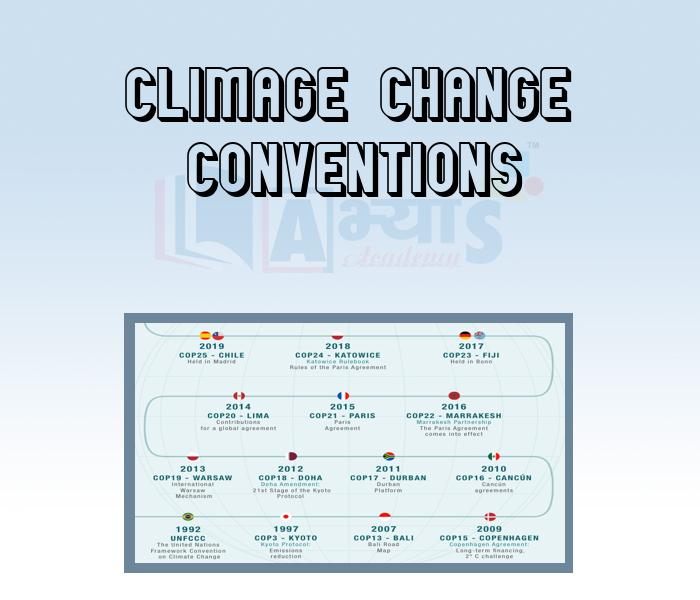Climage Change Conventions










Climage Change Conventions
Climate Change Conventions: The various conventions for tackling Global Warming:
From Kyoto to Copenhagen to Paris: The earth is already showing many signs of worldwide climate change:
Kyoto Protocol: The Kyoto Protocol is an international agreement linked to the United Nations Framework Convention on Climate Change. The major feature of the Kyoto Protocol is that it sets binding targets for 37 industrialised countries and the European community for reducing greenhouse gas (GHG) emissions. This amounts to an average of five per cent against 1990 levels over the five-year period 2008-2012.
Recognising that developed countries are principally responsible for the current high levels of GHG emissions in the atmosphere because of more than 150 years of industrial activity, the Protocol places a heavier burden on developed nations under the principle of "common but differentiated responsibilities". The Kyoto Protocol was adopted in Kyoto, Japan, on December 11, 1997 and brought into force on February 16, 2005. 184 Parties of the Convention have ratified its Protocol to date.
Copenhagen Accord: The Copenhagen Accord, the first global agreement of the 21st century to comprehensively influence the flow and share of natural resources, was agreed upon by 26 most influential countries in the wee hours of December 19, 2009, in the capital of Denmark.
The accord demands that increase in global temperatures be kept below 2 degrees based on equity. It requires global emissions as well as all national emissions to peak at a certain time but is mindful of concerns of economic development.
Cancun Conference: The United Nations Climate Change Conference took place in Cancun, Mexico, from 29 November to December 2010. It encompassed the sixteenth Conference of the Parties (COP) and the sixth Conference of the Parties serving as the Mecting of the Parties to the Kyoto Protocol (CMP).
Students / Parents Reviews [10]
My experience was very good with Abhyas academy. I am studying here from 6th class and I am satisfied by its results in my life. I improved a lot here ahead of school syllabus.

Ayan Ghosh
8thBeing a parent, I saw my daughter improvement in her studies by seeing a good result in all day to day compititive exam TMO, NSO, IEO etc and as well as studies. I have got a fruitful result from my daughter.

Prisha Gupta
8thOne of the best institutes to develope a child interest in studies.Provides SST and English knowledge also unlike other institutes. Teachers are co operative and friendly online tests andPPT develope practical knowledge also.

Aman Kumar Shrivastava
10thAbout Abhyas metholodology the teachers are very nice and hardworking toward students.The Centre Head Mrs Anu Sethi is also a brilliant teacher.Abhyas has taught me how to overcome problems and has always taken my doubts and suppoeted me.

Shreya Shrivastava
8thIt was good as the experience because as we had come here we had been improved in a such envirnment created here.Extra is taught which is beneficial for future.

Eshan Arora
8thI have spent a wonderful time in Abhyas academy. It has made my reasoning more apt, English more stronger and Maths an interesting subject for me. It has given me a habbit of self studying

Yatharthi Sharma
10thAbhyas is a complete education Institute. Here extreme care is taken by teacher with the help of regular exam. Extra classes also conducted by the institute, if the student is weak.

Om Umang
10thMy experience with Abhyas academy is very good. I did not think that my every subject coming here will be so strong. The main thing is that the online tests had made me learn here more things.

Hiya Gupta
8thMy experience with Abhyas is very good. I have learnt many things here like vedic maths and reasoning also. Teachers here first take our doubts and then there are assignments to verify our weak points.

Shivam Rana
7thA marvelous experience with Abhyas. I am glad to share that my ward has achieved more than enough at the Ambala ABHYAS centre. Years have passed on and more and more he has gained. May the centre flourish and develop day by day by the grace of God.
